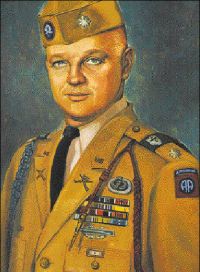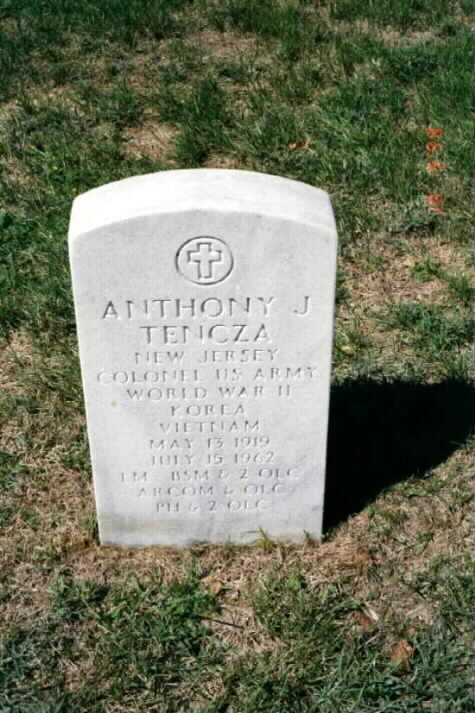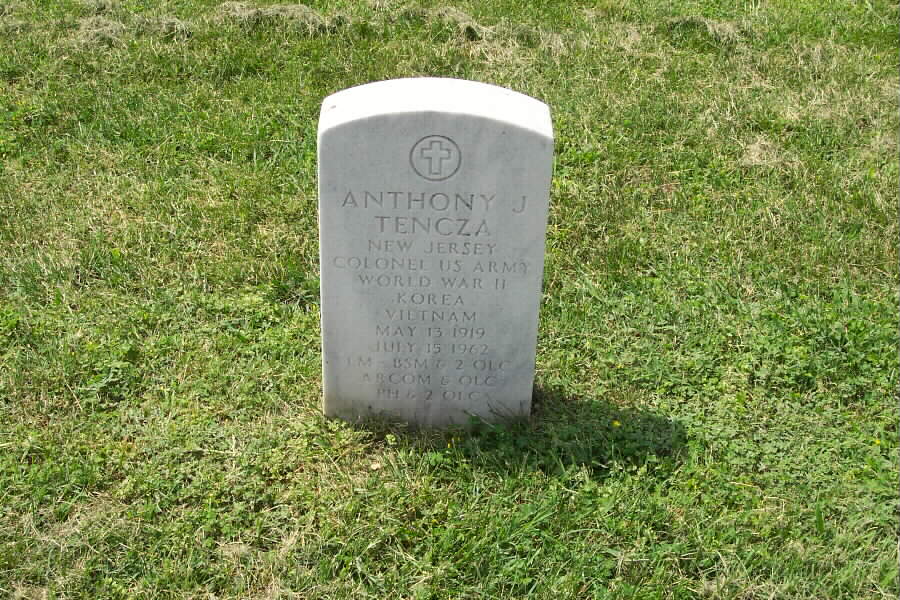Colonel Tencza spent 23 years in the US Army and held 5 medals for bravery in World War II and Korea.
He was Senior Advisor to the 22nd Vietnamese Division.
On July 15, 1962, while on supply mission, his helicopter was shot down by Viet Cong. He was knocked unconscious by the crash and, according to eyewitnesses, was shot in cold blood by guerrillas.
Before his requested assignment to Vietnam had come through, he was stationed at Fort Myer. It was therefore only fitting that his funeral should have been from the Chapel there.
May 12, 2006
Tencza Teardown – Remembering the high-rise namesake
by Matt McFarland, Pentagram staff writer
This potrait once hung in the Tencza Terrace lobby when the building was occupied. It is now in the safe keeping of Fort Myer Military Community historian Kim Holien.
Even with his life cut short in a Vietnam helicopter crash, Colonel Anthony Tencza lived longer than the building named after him.
Early next month Tencza Terrace, the lone member of the Fort Myer skyline, will be reduced to rubble 13 days before its 40th anniversary.
On June 17, 1966, the building was dedicated in honor of the man who was awarded the Legion of Merit and was posthumously promoted to colonel. His wife Pauline unveiled an oil portrait in the lobby of the 12-story high-rise. The post commander, Colonel Robert L. Walton attended along with Tencza’s children and parents.
Tencza’s H-21 helicopter was shot down in Vietnam on July 15, 1962 during a supply mission 20 miles from the Laos border. The crash knocked him unconscious. He was then fatally wounded from small arms fire according to reports in the Fort Myer Post, the Pentagram’s predecessor, and the Fort Myer Tour Guide.
Exactly one month earlier another former Fort Myer officer was killed in Vietnam. First Lieutenant William F. Train was ambushed outside Saigon. Prior to his service in Vietnam Train served as a public information officer with the Old Guard.
Four years later both men were honored with barracks named after them. The Train Barracks, Building 403, was the first tri-service complex in the United States.
In the 60’s the portion of Fort Myer known as South Post was being ceded to Arlington National Cemetery so the installation needed new buildings. Originally three high-rises were planned but during wartime funding was tight. At this time Rader Clinic was also built.
“Fort Myer has a long tradition of naming buildings after individuals who do great things for our country. Colonel Tencza was a true hero to his nation,” said Garrison Commander Colonel Thomas A. Allmon.
Tencza was born May 13, 1919 in Passaic, New Jersey. Tencza had two brothers and two sisters. He worked at a spring wire manufacture in New Jersey before graduating from officer candidate school at Fort Benning in 1942.
During World War II he was stationed in the United States. Tencza served in the occupation forces of Japan after the war. Later he was assigned to the 82nd Airborne Division at Fort Bragg, North Carolina. He also fought in the Korean War where he was wounded twice.
Following the war Tencza returned to Bragg and served as the Army’s Deputy Chief of Staff for Logistics.
A year later he first stepped foot on Fort Myer as the installation’s comptroller.
Call it fitting – the implosion of a building named after a budget expert will save the installation $100,000. Fort Myer officials considered knocking the building down with a wrecking ball, but realized it was more expensive.
In the spring of 1962 Tencza provided the clearest indication of his character: he passed up a desk job in the Pentagon to serve in Vietnam.
“Tencza personified the statement from the movie “Gettysburg:” To be a good Soldier, you must love the Army,” said Fort Myer Historian Kim Holien.
Tencza is buried in Section 3 of Arlington National Cemetery.
TENCZA, ANTHONY JOHN
- LTCOL USA
- DATE OF BIRTH: 05/13/1919
- DATE OF DEATH: 07/15/1962
- BURIED AT: SECTION 3 SITE 2502-1 L
ARLINGTON NATIONAL CEMETERY
Michael Robert Patterson was born in Arlington and is the son of a former officer of the US Army. So it was no wonder that sooner or later his interests drew him to American history and especially to American military history. Many of his articles can be found on renowned portals like the New York Times, Washingtonpost or Wikipedia.
Reviewed by: Michael Howard




